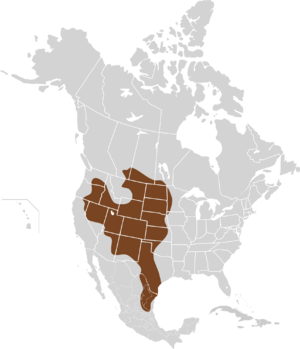Northern grasshopper mouse facts for kids
Quick facts for kids Northern grasshopper mouse |
|
|---|---|
 |
|
| Conservation status | |
| Scientific classification | |
| Genus: |
Onychomys
|
| Species: |
leucogaster
|
 |
|
The northern grasshopper mouse (Onychomys leucogaster) is a small rodent that lives in North America. It's part of a family called Cricetidae. These mice are special because they mostly eat meat! You can find them across the western parts of North America. Their home stretches from southern Saskatchewan and central Washington all the way to Tamaulipas in northeast Mexico.
About the Northern Grasshopper Mouse
The northern grasshopper mouse lives mainly in dry areas of North America. These mice are quite sturdy for their size. They are usually about 164 mm (6.5 in) long. They weigh around 35 g (0.077 lb). Their tail is shorter than many other mice. It's often less than 30% of their total body length.
These mice can be grayish or cinnamon in color. Their bellies are white. What makes them unique is their diet. Unlike most rodents, they are mostly carnivorous, meaning they eat meat. They mainly munch on small insects, other mice, and even snakes! Only a small part of their diet is plants. They eat more plants in the middle of winter.
The northern grasshopper mouse is also nocturnal. This means they are active at night. They are especially busy on nights when there's no moon or when it's cloudy. Throughout the night, they make high-pitched noises. They do this with their nose raised and mouth open. This helps them claim their territory. Bigger animals like hawks, owls, coyotes, and snakes often hunt them.
Where They Live
You can find this grasshopper mouse in prairies. They like areas with low grass and dry lands. They also live in pasture lands. These areas are mostly in the central and southwestern United States.
O. leucogaster sometimes lives near black-tailed prairie dogs. This might be because they both like disturbed areas. Prairie dog burrows also offer good homes. Plus, there might be food nearby.
Northern grasshopper mice live in burrows underground. They can dig their own burrows. Or they can move into burrows that other animals have left. These mice have a system of many burrows. Each burrow has a different job.
- The nest burrow is where they spend most of their day. They close the opening to keep moisture inside.
- A retreat burrow is for quick escapes. It goes about 10 inches into the ground. It's dug at a 45-degree angle.
- The cache burrow is used for storing seeds.
- Signpost burrows are small. They are filled with special scents. These scents mark the edges of their territory.
All these burrows are found within a large area that the mouse considers its home.
Reproduction and Life Cycle
The northern grasshopper mouse usually has two or three litters each year. A litter is a group of baby mice born at the same time. Each litter has two to seven young. The average is four babies.
They are pregnant for about 32 to 47 days. The babies are born in late fall or early winter. This is usually between September and February. The male mouse helps the female. He gathers and brings her food. He does this while she is pregnant and caring for the young.
Baby grasshopper mice are born altricial. This means they are born naked. Their eyes are closed. They weigh about three grams. Both male and female mice can have their own babies when they are three months old. However, most mice in the wild only live for a few weeks to a few months.


